Following our five-night stay at Raffles the Palm in Dubai, UAE, we checked out of our hotel and were transported to Port Rashid where we boarded Silversea’s Silver Spirit for a 33-day cruise that would take us from Dubai to Cape Town, South Africa.
Because of the conflict between Israel and Hamas, I must admit that we were more than a little concerned about traveling in this region. However, Silversea clearly communicated to passengers that there was no cause for worry, as every possible precaution had been taken to insure their safety. And they were absolutely correct, as we felt totally secure throughout our entire voyage.
Desert Dune Ride, Abu Dhabi, UAE: Since we had already explored a good bit of Abu Dhabi during our pre-cruise excursion – including the world-famous Sheikh Zayed Mosque, as well as a very brief visit to an outpost of the Louvre Museum – we decided to do something totally  different in nature: a hair-raising dune ride through a portion of the Al Sahara Desert.
different in nature: a hair-raising dune ride through a portion of the Al Sahara Desert.
And hair-raising it was… but great fun. This is, without doubt, as close as you can get to a roller coaster ride on terra-firma (and I love roller coasters). There were times when I was certain that our vehicle would turn over on its side… but, luckily, that never took place, as the drivers were extremely adept at negotiating our rousing passage through the dunes. Fortunately, we were not in an open vehicle, as all concerned would undoubtedly have been completely covered in sand.
World Trade Center, Al Manama, Bahrain: Al Manama, the capital of Bahrain, is as old as it is new. Here you discover remains of a 16th-century trade route port juxtaposed with steel and glass skyscrapers that line the streets of the busy financial district. The most striking of these, of course, is the 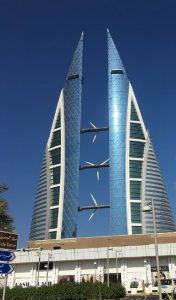 incredible World Trade Center, a 787 ft, 50-floor twin tower complex that houses both a five-star hotel and a luxury shopping mall, among its other intriguing attributes.
incredible World Trade Center, a 787 ft, 50-floor twin tower complex that houses both a five-star hotel and a luxury shopping mall, among its other intriguing attributes.
Designed by Atkins, a multi-national architectural firm, construction of the towers was completed in 2008. It is the first skyscraper in the world to integrate wind turbines into its design, which were developed, built, and installed by the Danish company Norwin A/S.
The two towers are linked via three skybridges, each holding a 225-kW wind turbine. Each turbine is aligned north, the direction from which air blows in from the Persian Gulf. The sail-shaped buildings on either side are designed to funnel wind through the gap to provide accelerated wind passing through the turbines. This significantly increases their potential to generate electricity.
The wind turbines are expected to provide 11% to 15% of the towers’ total power consumption, which is equivalent to providing the lighting for about 300 homes, 258 hospitals, 17 industrial plants, and 33 car engines. On an average day, they are expected to operate 50% of the time.
Al-Fateh Mosque, Al Manama, Bahrain: At one time, the Al-Fateh Mosque, also known as the Al-Fateh Islamic Center, was one of the 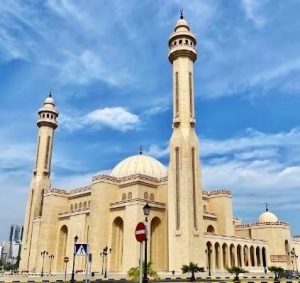 largest mosques in the world, having the capacity to accommodate over 7,000 worshippers at a time. The mosque was built by the late Sheikh Isa Bin Salman Al Khalifa in1987 and was named after Ahmed Al Fateh. In 2006, Al-Fateh became the site of the National Library of Bahrain.
largest mosques in the world, having the capacity to accommodate over 7,000 worshippers at a time. The mosque was built by the late Sheikh Isa Bin Salman Al Khalifa in1987 and was named after Ahmed Al Fateh. In 2006, Al-Fateh became the site of the National Library of Bahrain.
The mosque is located next to the Al-Fateh Highway in Juffair, a suburb of Manama. The huge dome on top of the mosque was constructed entirely of fiberglass. Weighing over 60 tons, it was originally the world’s largest fiberglass dome. The marble used in the floors is Italian and the chandelier was from 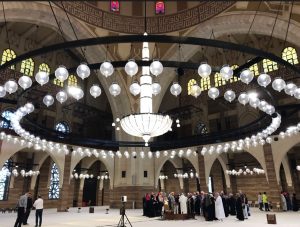 Austria. The doors were made of teak wood from India. Throughout the mosque is Kufic calligraphy.
Austria. The doors were made of teak wood from India. Throughout the mosque is Kufic calligraphy.
The library of Ahmed Al-Fateh Islamic Center contains approximately 7,000 books, several as old as 100 years or more. These include copies of the books of the teachings of the prophet Muhammad, or what is referred to as the books of Hadith, the Global Arabic Encyclopedia, the Encyclopedia of Islamic Jurisprudence, Al-Azhar Journals, which have been printed more than a hundred years ago, as well as numerous magazines and periodicals.
I liked Al-Fateh infinitely more than the aforementioned mosque in my first article – Sheikh Zayed Grand Mosque in Abu Dhabi – which gave the impression of being constructed strictly for tourists. Al-Fateh just had a much warmer atmosphere… And as we tiptoed our way through its precincts in our stocking feet, there was an instructional class going on, which only added to the feeling of intimacy. Definitely worth a visit.
King Abdulaziz Center for World Culture, Dhahran, Saudi Arabia: Also known as Ithra, this is, without doubt, modern architecture in 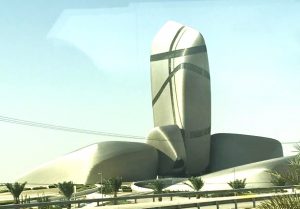 extremis. Whether observed from a distance, or up close and personal, the structure is equally mind-boggling. The building covers some 80,000 square meters, its intriguing shape inspired by the internal structural shape of oil-bearing rock formations. The Norwegian architectural firm Snohetta designed the building and Buro Happold, a UK professional services firm, was in charge of the engineering design. It was built and is operated by Saudi Aramco, and was inaugurated by King Salman bin Abdulaziz on December 1, 2016. The Center is located where the first commercial Saudi oilfield was discovered in March 1938.
extremis. Whether observed from a distance, or up close and personal, the structure is equally mind-boggling. The building covers some 80,000 square meters, its intriguing shape inspired by the internal structural shape of oil-bearing rock formations. The Norwegian architectural firm Snohetta designed the building and Buro Happold, a UK professional services firm, was in charge of the engineering design. It was built and is operated by Saudi Aramco, and was inaugurated by King Salman bin Abdulaziz on December 1, 2016. The Center is located where the first commercial Saudi oilfield was discovered in March 1938.
And the building’s interior is equally striking. The interior levels are arranged thematically to suggest a progression through time. Areas dealing with the past are at the lowest levels, while the present is represented on the ground floor. The higher levels are mainly situated in the building’s Knowledge Tower, to indicate that the knowledge communicated in the tower’s teaching rooms will equip citizens for the future.
The Center’s facilities are, indeed, impressive. The Museum is situated on four levels and is arranged thematically into four galleries: contemporary art, Saudi heritage, Islamic civilization, and natural history and human ecology. The contemporary art, heritage, and Islamic civilization galleries have non-permanent displays and change their exhibitions on a regular basis. From 2018 to 2020, for example, the Islamic civilization gallery hosted an exhibition of Islamic art in conjunction with the Los Angeles County Museum of Art.
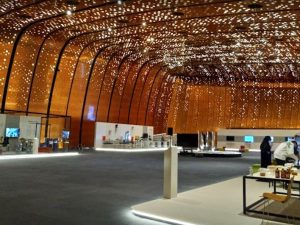 The Center’s Great Hall (pictured) is the dedicated area for short-term exhibitions. It has hosted an exhibition of original paintings by Norwegian Expressionist artist Edvard Munch, as well as an exhibition of manuscripts by Leonardo da Vinci.
The Center’s Great Hall (pictured) is the dedicated area for short-term exhibitions. It has hosted an exhibition of original paintings by Norwegian Expressionist artist Edvard Munch, as well as an exhibition of manuscripts by Leonardo da Vinci.
Other facilities include the Ithra Cinema, which is one of the first to be operational in Saudi Arabia. It 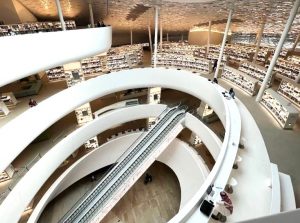 displays a mix of movies, including popular international features, documentaries, and independent productions. The Ithra Library (pictured) is one of the largest and modern in the region. It is designed to host about 500,000 texts, as well as a variety of digital resources, and also hosts workshops, lectures, and book clubs. In addition to performances, the Ithra Theater also organizes events intended to develop theater in Saudi Arabia, displays local & international plays, and offers theatrical training workshops. The Energy Exhibit offers visitors an ever-popular introduction to the oil industry, including renewables, ecology, and technology.
displays a mix of movies, including popular international features, documentaries, and independent productions. The Ithra Library (pictured) is one of the largest and modern in the region. It is designed to host about 500,000 texts, as well as a variety of digital resources, and also hosts workshops, lectures, and book clubs. In addition to performances, the Ithra Theater also organizes events intended to develop theater in Saudi Arabia, displays local & international plays, and offers theatrical training workshops. The Energy Exhibit offers visitors an ever-popular introduction to the oil industry, including renewables, ecology, and technology.
Time magazine listed the King Abdulaziz Center for World Culture as one of the world’s top 100 places to visit; and it attracted one million visitors in 2019. If you are planning a sojourn to the Saudi Arabia, the Center is definitely a must-see.
Sultan Qaboos Grand Mosque, Muscat, Oman: In 1992, or so the story goes, the then Sultan of Oman, Qaboos bin Said al Said, decided that his country should have a grand mosque…. And the rest, as they say, is history.
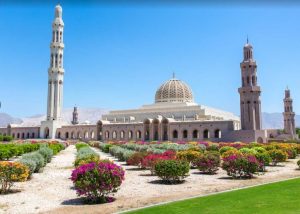 The grand mosque was inaugurated by the Sultan himself on May 4, 2001, as a gift to the nation to celebrate his third decade in power. His policies found favor with many, as his enlightened leadership spearheaded Oman toward becoming a modern state while still preserving age-old traditions of the Islamic way of life.
The grand mosque was inaugurated by the Sultan himself on May 4, 2001, as a gift to the nation to celebrate his third decade in power. His policies found favor with many, as his enlightened leadership spearheaded Oman toward becoming a modern state while still preserving age-old traditions of the Islamic way of life.
An architecture competition took place in 1993 to select the best design for the mosque. Once the winner was determined, the mosque took six years and seven months to build. Featuring a combination of Islamic, Middle Eastern, and Omani architectural styles, it was constructed utilizing 30,000 tons of pink sandstone imported from India, as well as local granite and white marble. Five minarets were built around the periphery. The main minaret, 300-feet in height, and the four flanking minarets, 149-feet, are the mosque’s chief exterior features.
The mosque is Oman’s largest with a capacity for 20,000 worshippers: 6,500 in the main musalla prayer hall, 750 in the women’s musalla, and an additional 8,000 in the outer paved grounds, interior courtyard, and along the passageways.
The enormous Italian-manufactured 24-carat gold-plated chandelier, once the world’s largest, weighs 8.5 tons, is trimmed with 600,000 Swarovski 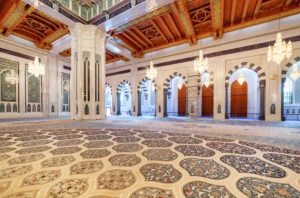 crystals, contains 1,122 halogen bulbs, and also includes a dimming system and a staircase for maintenance within the chandelier. Thirty-four smaller chandeliers of the same design are hung in other parts of the building.
crystals, contains 1,122 halogen bulbs, and also includes a dimming system and a staircase for maintenance within the chandelier. Thirty-four smaller chandeliers of the same design are hung in other parts of the building.
Equally magnificent is the hand-loomed carpet (pictured) that covers the floor of the prayer hall. Containing 1.7 million knots, 28 natural vegetable dyes, and weighing 21 tons, it brings together the classical Persian Tabriz, Kashan, and Isfahan design traditions, and took four years to produce. The carpet measures 230 by 200 feet and covers the 46,750 square feet area of the prayer hall.
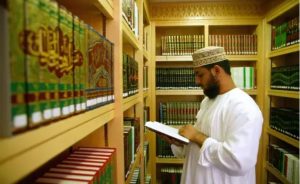 The double-story library is a striking cultural representative of Oman’s contemporary renaissance inspired by the late Sultan. It contains more than 23,342 books on the topics of Islamic culture, natural science, fine arts, philosophy, and psychology within its six departments, including a children’s section. The collection of predominantly Arabic and English titles grows larger each year.
The double-story library is a striking cultural representative of Oman’s contemporary renaissance inspired by the late Sultan. It contains more than 23,342 books on the topics of Islamic culture, natural science, fine arts, philosophy, and psychology within its six departments, including a children’s section. The collection of predominantly Arabic and English titles grows larger each year.
Another must-see during your journey to the Middle East.
Bon Appétit & Cheers!
TAD
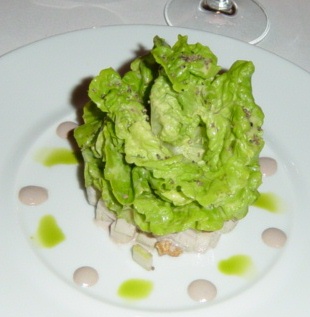
{ 0 comments… add one now }